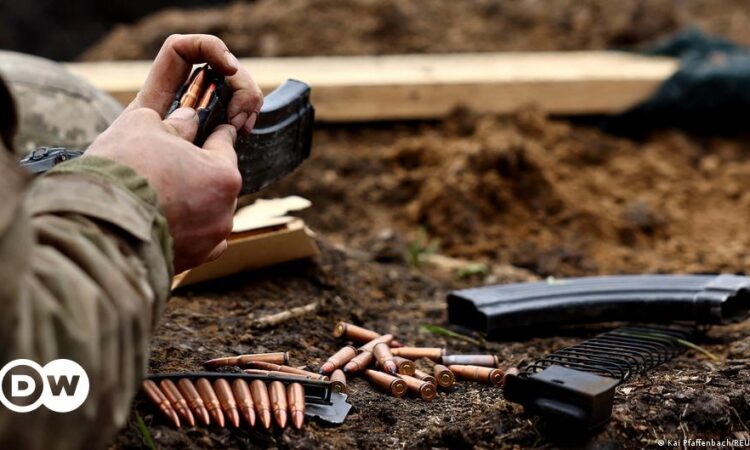
Amid months of headlines about Ukraine’s dwindling stocks of ammunition as it fights off Russia, the European Union unveiled a fresh initiative to speed up its own arms manufacturing over the next 12 months on Wednesday.
“The European defense industry has to see how we can move into war economy mode,” European Internal Market Commissioner Thierry Breton, who has been touring munitions factories in the past few weeks, told reporters in Brussels.
“We’re talking about expanding existing production, modernizing production, perhaps creating new production lines and new factories within plants which are already there, and also reconversion of old ammunition plants, which can be adapted to current standards,” he said.
Under the plan, EU businesses would be able to benefit from up to €500 million ($552 billion) worth of subsidies from the bloc’s shared budget. All projects must co-financed by member states — potentially adding another €500 million, according to Breton.
“I think that within 12 months’ time, with support, we will be able to ramp up our production capacity to 1 million shells per year in Europe,” Breton said, declining to reveal the closely guarded secret of current manufacturing capacity.
The senior EU official said he hoped the proposal would be signed off by June. The two-year initiative would also allow member states to allocate EU coronavirus recovery funds and money for poorer regions (so-called cohesion funds) for certain investments.
Three-pronged plan to further arm Ukraine
Wednesday’s announcement is the third and final pillar in a plan agreed among EU member states in March, each worth around €1 billion.
The first uses shared funds to partially reimburse EU states for weaponry sent to Kyiv from their own stockpiles and has been underway for some time. In fact, Estonia fielded criticism in recent weeks for allegedly taking advantage of joint EU funds to replace ageing stocks — an accusation Tallinn vehemently denied.
The second involves joint procurement of ammunition for Ukraine but was held up by a behind-the-scenes political showdown over whether non-EU defense companies could benefit from the valuable contracts if they could deliver quicker than EU competitors. EU ambassadors put aside their differences and struck a deal on Wednesday, according to current EU presidency holder Sweden, clearing the way for collective purchasing to go ahead.
EU ‘breaking new ground’ with weapons subsidies
The EU has broken many of its previous taboos since Russia launched its full-scale invasion of Ukraine last February. Founded as a peacekeeping project as Europe picked itself up from the devastation of World War II, the EU has normally prohibited spending shared funds on military equipment for active conflict zones.
But the outbreak of war on the political community’s doorstep and a determination to back Kyiv against Moscow led to a rethink — and the creation of novel “off-budget” finance mechanisms for massive military aid.
“I think we should recognize that the Commission is breaking new ground,” Camille Grand, an analyst from the European Council on Foreign Relations, told DW. “The EU, for the first time in fact, will be spending EU money on the defense industry, not only on research and development, but indeed to support the defense industry,” he noted.
No quick fix, expert warns
The €500 million is a significant chunk of money, though it remains to be seen if it will have the desired effect as quickly as EU officials hope, according to Grand.
Stepping up arms production is a notoriously long-winded process, Grand explained. While ammunition is simpler and quicker to make than tanks or aircraft, it still takes time to ramp up complicated supply chains and build up the necessary highly skilled workforce. Production could be increased in a few months, he said.
Fundamentally, Europe’s production capacities were not set up for the scenario of a major war, the analyst said. “The term ‘war economy’ might be a little far-fetched, but it is sort of telling us something about how much we need to change,” he said.
At the same time, the defense industry has been skittish about massively increasing its production capacity only to find demand suddenly drop off if the war in Ukraine ends.
Combined initiatives from Western military alliance NATO and the EU “give a signal to industry that it is worthwhile investing in this,” Grand said. “First of all, because parts of the investment will be covered by the European Union, but also because there will be a demand that will last for several years rather than a few weeks or a few months.”
Anti-poverty funds for ‘war economy’?
While the EU may be breaking new ground, not everyone is happy about the idea of seeing pots of EU money meant to help countries recover from the pandemic or reduce inequality potentially going to the defense industry.
Martina Michels, a member of the European Parliament from the German socialist Left Party, criticized this aspect of the plan in a written statement.
“The EU’s structural funds are our instruments for strategic long-term investment. They are intended to promote the harmonization of living conditions while at the same time promoting climate-friendly structural change,” Michels wrote. “Under no circumstances should they be used for armaments. A war economy is neither socially nor ecologically nor economically sustainable.”
Breton pointed out that it was up to member states whether they chose to top up investments using funds in this way. For example, the use of cohesion funds might be used to build back up a munitions factory that had downsized in recent years, he said.
“We’re going to have act very quickly in terms of funding and allow the industrial sector to ramp up,” he said.
Edited by: Timothy Jones






